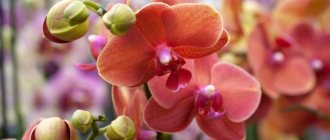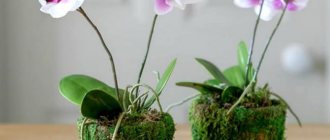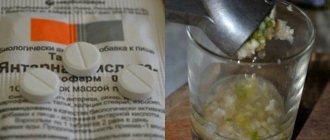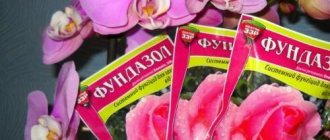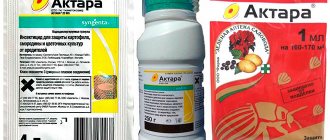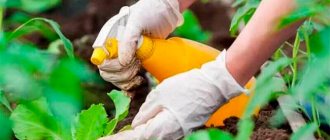Description and active ingredient of the drug "Aktara"
"Aktara" is a chemical insecticide developed in Swiss laboratories. The drug is available in the form of granules that do not dissolve, and when diluted with water they form a homogeneous suspension. This form of release is called “water-dispersible granules” and is designated on the packaging by the abbreviation “VDG”.
The basis of the drug is a chemical compound from the class of neonicotinoids - thiamethoxam. This is a strong nerve poison that can destroy insects on a plant in a few hours, working according to the following mechanism:
- the substance penetrates the orchid tissue and is distributed in the cell sap;
- the insect, feeding on the juices of the plant, eats the poison;
- within a few hours the insect is paralyzed and dies.
“Aktara” applied to the upper side of the orchid leaf blades, thanks to the translaminar effect, is distributed throughout the leaf tissues and protects the lower side. If the drug was applied at the root of the orchid, within 1-3 days it will be distributed throughout all organs of the plant.
Important! A number of studies have shown that thiamethoxam, once in plant tissue, soon forms a metabolite, clothianidin. This is another neonicotinoid that has high resistance and speed of action on pests. Thanks to such chemical transformations, Aktara retains its protective effect for 2 months after treatment.
When processing orchids by leaves, Aktara exhibits translaminar properties. When applied by irrigation - systemic.
Scope of application
Actara acts on nicotinic acetylcholine receptors in the nervous system of insects.
The main active ingredient penetrates deep into the leaves, moving through the vascular system. The drug is redistributed throughout the tissues twenty hours after watering. After 1-3 days it reaches the upper parts of the peduncle and the tips of the leaves. Each gardener uses Aktaru at his own discretion. Sometimes the insecticide is diluted in the required amount of water to protect the plant from the pest (the period of action is 14-28 days when spraying leaves and 40-60 days when watering the soil). Experienced flower growers know that it is necessary to increase the dosage of the drug with repeated treatments. Without doing this, they are not surprised by repeated outbreaks of aphids or scale insects.
The main area of application is the control of pests, more precisely their larvae, which can hatch from eggs laid deep in the substrate.
List of orchid pests sensitive to Aktara
"Aktara" is famous for having a fairly wide spectrum of action. The official regulations provide for the use of this drug on potted indoor plants to protect against the following insects:
- soil flies;
- thrips;
- whiteflies;
- aphids;
- fungus gnats;
- scale insects;
- false scale insects.
In fact, the spectrum of action of this drug is wider. In particular, many gardeners effectively use Aktara to combat the most insidious pest of orchids - the mealybug.
Tip #1. The drug "Aktara" is effective only against insects. If the orchid is affected by spider mites, it is useless to use insecticides. To combat ticks, agents from the class of acaricides or insectoacaricides are needed.
What is it and how to properly dilute the insecticide?
Definition Aktara is an insecticide that belongs to the group of neonicotinoids. It is compatible with other growth regulators, insecticides and fungicides. It is effective when the orchid is affected by pests from the list below.
- spider mite;
- fungus gnats;
- mealybug;
- scale insect;
- thrips;
- aphid;
- flatfish.
On a note. It is produced in Switzerland. In addition to pest control on orchids, it is suitable for preventative treatment. Aktara is an effective remedy for protecting vegetables, roses in the garden and home violets.
Dilution and use of Aktary working fluid
Water-dispersible granules must be diluted with water before use. The drug "Aktara" is very strong, the concentration of the active substance in it is high, so dilution is done in a large amount of water:
| Pest | Preparation of working solution | Mode of application |
| Aphids, thrips, whiteflies | 1 g of granules is diluted in 10 liters of water to obtain a homogeneous suspension | Spraying the solution on leaves, pseudobulbs, trunks, peduncles, the top layer of the substrate and aerial roots |
| Fungus gnats and soil flies | 1 g of granules is diluted in 10 liters of water | Pouring the pot with 1 cup of working liquid over a pre-moistened substrate |
| Scale insects, false scale insects, mealybugs | 8 g of granules are diluted in 10 liters of water | Spraying the solution on leaves, pseudobulbs, trunks, peduncles, the top layer of the substrate and aerial roots |
Such a strong dilution of the Aktara preparation makes it not very convenient for use in indoor floriculture, because 10 liters of working suspension is enough to treat 250-300 pots of orchids. The prepared liquid cannot be stored, so the florist is faced with either the problem of disposal or the question of preparing a smaller volume of suspension.
Disposing of chemical pesticide residues into sewers or septic tanks is prohibited. In order not to violate this prohibition, it is useful for orchid lovers to have laboratory scales on their farm. With their help, you can accurately measure ultra-small amounts of drugs and prepare strictly the required amount of working solutions:
- 0.1 g of granules per 1 liter of water – for treating 6-8 orchids against aphids, thrips, whiteflies;
- 0.1 g of granules per 1 liter of water – to treat 4-5 orchids against fungus gnats and soil flies;
- 0.8 g of granules per 1 liter of water – for treating 6-8 orchids against scale insects, false scale insects and mealybugs.
If there are even fewer orchids in the collection, you need to measure out a smaller amount of the Aktara preparation.
If it is not the green organs that are affected by pests, but the orchid flowers, it is advisable to combine two methods of using Aktara - spraying and watering. You need to spray only on the green parts, without touching the flowers and buds. The active substance will reach them through the roots through the conduction system.
Infectious diseases of orchids
It is very interesting to listen to experts and flower growers about the proper care of orchids. And how to deal with various diseases of these plants. But how do orchids cope with such a horde of diseases in their real habitats? Or are there fewer of them? After all, the conditions are natural.
We ourselves are to a greater extent the culprits of their diseases . Either overfilled or underfilled. It's hot, it's cold.
The main cause of disease is improper care.
The main causes of fungal diseases of orchids:
- Root damage. Like during transplants. So and by various pests;
- Excessive watering and stagnation of moisture;
- Poor room ventilation;
- Oversaturation with nitrogen fertilizers;
- Poor quality substrate. Especially its salinity;
- Unacceptable drop in ground temperature;
- Lack of microelements that provide protective functions of plants.
This is interesting: How to properly soak corn before planting All parts of the plant can be affected by infections. Regular inspection of plants allows you to quickly detect that not everything is in order with the plant.
Leaves can signal this:
- Darkening;
- Drying and stains;
- Lumps and swellings.
Careful inspection of transparent containers will help determine the condition of the root system. Most often, at home you have to deal with infectious diseases of orchids, which we will discuss below.
Gray rot
Gray rot most often appears on mature plants in the form of brown spots on flowers . Stagnation of cool and humid air most contributes to the development of fungi of this disease. In autumn or spring.
Infection occurs quite quickly: 12-15 hours is enough for nearby other plants to become ill.
Gray rot.
Black rot
The appearance of this disease in orchids is greatly facilitated by pests (bugs, aphids, scale insects). And high humidity and oversaturation of nitrogen in the soil only help its spread.
Black rot.
Anthracnose
Clear small brown spots of a round shape on the leaves ... They indicate that the plant has anthracnose disease:
- Subsequently, the leaves become covered with a black coating or mold with a pinkish tint;
- The affected area is rapidly expanding. If you delay treatment, they can connect and form dents;
- High humidity and stagnant moisture in the leaf axils and cores of pseudobulbs can cause the disease;
- Miltonia, Oncidium, Paphiopedilum, and Phalaenopsis are most often affected.
Thrips
Adult insects have an oblong body 2.5 mm long and live on the soil surface. Thrips on orchids look like tiny black sticks with small wings. Females lay eggs on leaf blades.
You can recognize an orchid infestation with thrips by yellow spots with dots on the leaves and brown necrotic areas on the shoots. The larvae feed on plant sap, which they suck from leaves, buds, and flowers. To examine insects at this stage of development, you need to use a magnifying glass.
Pests enter a room with infected orchids or other plants, or bouquets of flowers. It is necessary to quarantine for two weeks for each new pet in the green corner.
Thrips on an orchid
The fight against the spread of thrips involves improving the light regime and using insecticides. Effective drugs - Aktara, Insektor. A solution of systemic pesticides can not only be sprayed, but also watered on the substrate. The active substance penetrates through the roots into all organs of the plant.
Among biological products for treatment against thrips, it is recommended to give preference to Vertimek and Fitoverm. Spray orchid leaves on both sides, shoots, and aerial roots with an insecticide of biological origin. The disadvantage of biological products is the need for 2 or 3 treatments over 7–10 days.
Folk remedies have low effectiveness against thrips. Often, the use of decoctions and infusions of herbs takes time, but does not lead to the desired result. In case of severe damage, the sequential use of two different insecticides is required: first chemical, and after a week biological.
Shchitovka
The shield aphid is a dangerous pest of orchids. A sign of infestation by this insect is the appearance of small brown scales or waxy tubercles and sticky secretions on the leaves and stems. It is difficult to remove an adult pest - it literally digs into plant tissue.
Shield aphid
The insect's body length is from 1.5 to 4 mm. Wings develop only in males, but the oral apparatus is reduced. Large females do not have legs or wings. The wax-like shield protects well from the penetration of chemicals through the integument into the body.
Scale insects and false scale insects are combined into one superfamily of coccids or scale insects - sucking insects that are dangerous to many plants. Pests of orchids - 4–5 types of scale insects, soft false scale insects. Controlling this group of insects is extremely difficult.
Before getting rid of scale insects on an orchid, you need to isolate the affected specimen from healthy plants. Then you should remove all the brown tubercles. It is recommended to change the substrate, disinfect the pot and treat the orchid with Actellik. Next, a second and third treatment will be required at intervals of 5–6 days.
Whiteflies
Small white midges in orchids spread quickly and infect almost all plants in the collection. Whiteflies are small insects with folded wings. The top of the body seems to be covered with a layer of white powder.
Whitefly
Infestation by these insects causes leaves to turn yellow and fall off. Under the influence of a pest, the plant becomes more susceptible to fungal, viral and bacterial infections.
They begin the fight against whiteflies by replacing the substrate in pots and removing affected leaves. Plants are treated with Aktara, Fitoverm or Aktellik. The soil is watered with a weaker solution of one of the drugs. Fitoverm is effective only with repeated treatments or in combination with other insecticides.
Aphids on an orchid
Small insects suck sap from different parts of plants, transmit viral diseases, and create a favorable environment for the proliferation of sooty fungus. An aphid attack on an orchid is recognized by sticky spots, deformed leaves, fallen unopened buds and dried flowers. Pests form colonies under leaves, on flowers and on the tops of young shoots.
Aphids on an orchid
Aphids are sedentary insects 1–5 mm long. The body is oval in shape, colored in shades of green, pink, brown or black. There are wingless and winged aphids that lay eggs and are viviparous. Females are very fertile - producing more than 100,000 young in one month.
How to get rid of aphids on an orchid:
- Immediately wash the infected plant with a stream of water;
- wrap your fingers in a bandage and remove insects from the affected organs;
- in case of significant infestation, treat with a suitable insecticidal preparation - Fitoverm, Iskra or Aktara;
- repeat spraying after a week, use a different pesticide.
Nettle infusion is a folk remedy for aphids on orchids. Prepare from two handfuls of fresh leaves and 2 liters of cold water. Leave for 12 hours, filter, pour the solution into a spray bottle and treat the plants. The folk remedy works within a week.
You can replace nettle with celandine grass, marigolds, dried tangerine or orange peel, and dry tobacco leaves. It is recommended not only to spray the infected orchids with the prepared infusion, but also to “walk” along the lower surface of the leaves with a soft brush. After 15 minutes, the treated areas are washed with clean water.
This is interesting: Review of indoor flowers that can easily be grown from seeds
Spider and armored mites
The diameter of the oval body of the pest is less than 1 mm. The integument of spider mites is usually light green, orange or red-brown in color. Adults and larvae have a piercing-sucking type of mouthparts. Limbs - 4 pairs (aphids and other insects have 6 legs).
Spider mite
You can recognize spider mites on an orchid by the appearance of dots and pale yellow spots on the leaves. Pests weave webs around young shoots and buds. When mites multiply en masse, the leaves dry out and the entire orchid dies. Some species carry pathogens of infectious plant diseases.
The red spider mite is the most dangerous for orchids. Females are very fertile and lay eggs in a warm room all year round. It is useful to use a cold shower against spider mites. You can water the flower generously, cover with a transparent waterproof bag to increase humidity (remove after 3 days).
Pests are destroyed by spraying with Actellik. Rinse the pot with the drug solution and water the soil. There are other acaricides that are relatively safe for people: Fitoverm, Aktofit, Vertimek.
Decoctions of tobacco leaves and Dalmatian chamomile are destructive for ticks. The plants must be dried, finely chopped and left for 12 hours in cold water. The effect of folk remedies is short, so they are used mainly for prevention.
Orchid miteThe orchid mite looks like a tiny shiny ball on the protruding roots and lower part of the shoots. These arachnids feed on dying parts of plants. A large colony of oribatid mites switches to feeding on young leaves of phalaenopsis and dendrobium.
The method of controlling soil pests is to transplant plants into a healthy substrate. Before the procedure, it is necessary to clean the roots from mites. Use Aktellik or Fitoverm for soil etching. Another simple method is to periodically dry the substrate.
Powdery mildew
It is characterized by a covering of leaves and buds with a white coating . It’s as if flour was sprinkled on top:
- If measures are not taken, the plant may die;
- Greenhouse conditions (high humidity and high temperature) can most often cause the development of this disease;
- Affects most domestic orchids.
Fusarium
A dangerous disease of orchids with fungi of the genus Fusarium. There are root and stem forms :
- More often, infection can spread from newly acquired plants or seeds;
- It all starts with redness of the roots;
- Then impressions appear. The roots darken and begin to rot.
Fusarium.
Very important! The effectiveness of treatment depends on early detection and timely measures taken. And the correct use of treatments. A diseased plant must be immediately removed from other flowers.
Advantages and disadvantages of the drug "Aktara"
Before using the drug "Aktara" to rid orchids of pests, you need to weigh all its advantages and disadvantages:
| Advantages | Flaws |
|
|
Additional advantages of Aktara include the drug’s resistance to rinsing.
Since Aktara penetrates deeply into plant tissue, treated orchids can be safely sprayed or washed in the shower without fear of reducing the effectiveness of insecticidal protection.
Analogs of the drug "Aktara", acceptable for use on orchids
There are other drugs based on thiamethoxam on sale that can be considered as analogues of Aktara:
- "Doctor" from the "Green Gardener's Pharmacy". It is produced in the form of thiamethoxam-impregnated “arrows” - cardboard strips that are inserted into the substrate. When watering, the active substance is washed into the substrate. Convenient for protection against pests living in the substrate and on the roots of orchids.
- "Insector" from LLC "Your Farm". Available in the form of a concentrated suspension in bottles or dispensing syringes. Convenient for preparing working fluids at room conditions due to the ease of dosing.
In many cases, Aktara can be replaced with any other neonicotinoid - Biotlin, Tsvetolux Bau, Iskra Zolotaya, etc.
The “arrows” of the drug “Doctor” are increasingly becoming an alternative to the traditional “Aktara” in indoor floriculture. They are easy to use, and the systemic activity of thiamethoxam allows the poison to reach not only root but also ground pests.
Step-by-step processing instructions
The orchid is treated with Aktara after noticing the first mite, beetle, or caterpillar. Proceed as follows:
Carefully select the place where the treatment will be carried out. Orchid is a house plant. The pot is transferred to a room that is well ventilated.- The solution is prepared immediately before treatment in a backpack sprayer. It is not stored ready-made: it is diluted exactly as much as needed.
- For preparation, take 5 liters of water (25⁰C). 4 grams of the drug are diluted in this amount of water.
- After thorough mixing by shaking, the solution is ready for use.
Dosage
Orchid is an indoor flower. To spray it, take 4 grams of the drug. This amount is diluted in five liters of water at room temperature. With this amount of Aktara you can treat not only one orchid, but 124 more flowers. If desired, water the substrate with the product, diluting it in a different concentration: 1 gram per 10 liters. If there are a lot of pests, water the soil and spray the above-ground part of the plant at the same time.
- 4 grams of the drug in five liters of liquid. This breeding scheme is used to protect the orchid from pests.
- One ampoule per 0.75 liters of water. This is how Aktara is bred to combat spider mites, aphids, etc.
Watch the video on how to measure the required amount of Aktara if you do not need the entire package at once:
Plant treatment
Aktara is a drug that is used not only for preventive and therapeutic purposes. It is used to process material that is transplanted into another pot. In this case, make a highly concentrated solution by diluting 4 grams of powder in a liter of water. Complete decomposition occurs after sixty days. Parts of the plant are soaked in the solution before replanting so that they become stronger, take root after replanting and are not susceptible to pests.
Aktara is a drug that, if the dosage is exceeded many times (for example, the concentration is twenty times higher than the manufacturer recommends), will not harm the orchid. Flower growers are not afraid to measure out a little more than 4 grams of powder. Its peculiarity is that in a few days it turns the plant sap into poison for pests.
Note! If you water the flower before treatment, the concentration of the solution absorbed by the roots decreases and the beneficial effect decreases. It is not possible to remove aphids or scale insects in one go.
Reviews from flower growers about the drug "Aktara"
The high efficiency of Aktara is confirmed by the reviews of many lovers of indoor orchids:
“I buy new specimens of orchids often and anywhere, so I have pests from time to time. I can only deal with mealybugs, scale insects and thrips with Aktara. For some reason no other chemistry works for them. I dilute it not according to the instructions, I pour a 4 gram sachet into a bottle with 4 liters of water. It turns out to be a fairly strong solution, grams per liter, but it definitely kills all enemies. Orchids react calmly to this drug” (Marina, Tomsk).
Expert advice on treating orchids with chemical insecticides
Despite the low phytotoxicity of Aktara, experts warn about the need to take precautions when working with this drug:
“Dosages are written in instructions for a reason. Chemicals may be conditionally non-phytotoxic, but when the recommended dosages are grossly exceeded, they begin to inhibit plants. The concept of “lack of resistance” is also very conditional. Insects eventually get used to any chemical influences. Therefore, even such drugs to which no cases of addiction have been identified in pests should alternate with chemicals from other classes or with biological insecticides.”
S. Ryzhkova, florist with 15 years of experience
Practice shows that Aktar can be alternated with drugs from the following classes:
- pyrethroids (“Alatar”, “Inta-Vir”);
- avermectins (“Fitoverm”, “BioKill”);
- bacterial insecticides (“Lepidocid”, “Bitoxibacillin”).
Rotation of Aktara with bacterial insecticides and avermectins gives the best results. It must be performed according to a certain scheme. When the orchid is severely damaged by pests, “Aktara” is used. After 2-3 weeks, the plant is treated, for example, with Fitoverm. After another 2 weeks, a control treatment with Fitoverm is performed.
The use of competent rotation schemes for chemical and biological insecticides is guaranteed to protect orchids from pests, reduce the risk of developing resistance and reduce the pesticide load on plants.
Security measures
Thiamethoxam belongs to substances of the third class of danger. When using it, the following rules should be observed:
- Do not dilute the drug in containers intended for food products.
- The insecticide must be stored out of the reach of children and animals.
- You can work with the drug either outdoors or in a ventilated area.
- The treatment is carried out wearing gloves and safety glasses.
If the product gets on the skin or mucous membranes, rinse the affected areas thoroughly with water.
The shelf life of the drug in the package is 4 years. The remaining solution is disposed of immediately after use. It cannot be stored and left until the next processing.
5/5 — (2 votes)



